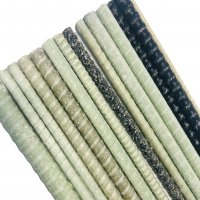jar546
CBO
Composite rebar, also known as fiber-reinforced polymer (FRP) rebar, is a type of reinforcement material that is made of a combination of fibers and resin. This material has several benefits that make it attractive for use in construction projects.
One of the main benefits of composite rebar is its strength. The fibers used in the rebar are typically made of carbon or glass, which are both extremely strong materials. This means that composite rebar can be used in applications where traditional steel rebar may not be strong enough. Additionally, composite rebar is also resistant to corrosion, which is a significant drawback of traditional steel rebar.
Another benefit of composite rebar is its lightweight. Because it is made of fibers and resin, it is much lighter than traditional steel rebar. This makes it easier to transport and handle, which can save time and money on construction projects.
Composite rebar also has thermal insulation properties, it can help to reduce the temperature of concrete structures, which can be beneficial in hot climates.
However, composite rebar also has some downsides. One of the main downsides is its cost. Because it is a newer and less common material, it can be more expensive than traditional steel rebar. Additionally, composite rebar is not as widely available as traditional steel rebar, which can make it harder to find and purchase.
Another downside of composite rebar is that it is less ductile than steel, which means it is less capable of absorbing energy and more likely to crack under stress. This may make it less suitable for use in certain types of construction projects.
In conclusion, composite rebar has several benefits, such as strength, corrosion resistance, lightweight and thermal insulation properties, but it also has some downsides, such as cost, availability, and ductility. Its use should be carefully considered and weighed against the specific needs of a construction project.

One of the main benefits of composite rebar is its strength. The fibers used in the rebar are typically made of carbon or glass, which are both extremely strong materials. This means that composite rebar can be used in applications where traditional steel rebar may not be strong enough. Additionally, composite rebar is also resistant to corrosion, which is a significant drawback of traditional steel rebar.
Another benefit of composite rebar is its lightweight. Because it is made of fibers and resin, it is much lighter than traditional steel rebar. This makes it easier to transport and handle, which can save time and money on construction projects.
Composite rebar also has thermal insulation properties, it can help to reduce the temperature of concrete structures, which can be beneficial in hot climates.
However, composite rebar also has some downsides. One of the main downsides is its cost. Because it is a newer and less common material, it can be more expensive than traditional steel rebar. Additionally, composite rebar is not as widely available as traditional steel rebar, which can make it harder to find and purchase.
Another downside of composite rebar is that it is less ductile than steel, which means it is less capable of absorbing energy and more likely to crack under stress. This may make it less suitable for use in certain types of construction projects.
In conclusion, composite rebar has several benefits, such as strength, corrosion resistance, lightweight and thermal insulation properties, but it also has some downsides, such as cost, availability, and ductility. Its use should be carefully considered and weighed against the specific needs of a construction project.

